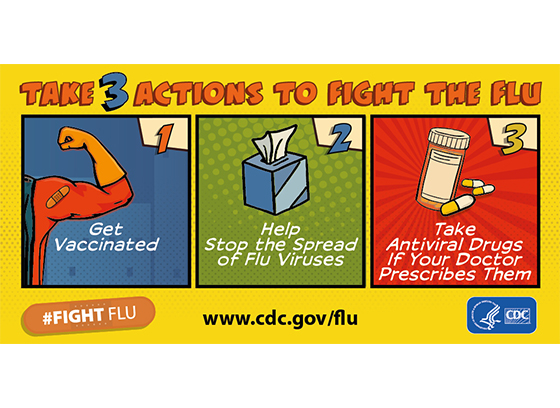Flu Prevention
The Health Department encourages people of all ages to get a seasonal flu shot from a healthcare provider, local pharmacy, retailer or big box store. Flu vaccination can reduce flu illnesses, doctors’ visits, and missed work and school (even virtual school) due to flu, as well as prevent flu-related hospitalizations and deaths.

The Howard County Health Department will update the list below with upcoming community flu clinics. The annual flu vaccine is also available from most local healthcare providers, pharmacies, urgent care centers and many large retail locations.
| Flu Vaccine Clinic Location | Date & Time | Registration |
|---|---|---|
|
|
|
Are you a senior who needs a ride to your flu shot? Neighbor Ride provides a FREE ride to your chosen provider. For more information, visit neighborride.org/freeride or call 410-884-RIDE (7433)
Flu prevention tips:
- Avoid close contact with sick people.
- While sick, limit contact with others as much as possible to keep from infecting them.
- If you are sick with flu-like illness, CDC recommends that you stay home for at least 24 hours after your fever is gone except to get medical care or for other necessities. (Your fever should be gone for 24 hours without the use of a fever-reducing medicine.)
- Cover your nose and mouth with a tissue when you cough or sneeze. After using a tissue, throw it in the trash and wash your hands. (Or cough or sneeze into the bend in your elbow.)
- Wash your hands often with soap and water. If soap and water are not available, use an alcohol-based hand rub.
- Avoid touching your eyes, nose and mouth. Germs spread this way.
- Clean and disinfect surfaces and objects that may be contaminated with germs like flu.
More information:
Avoid close contact with people who are sick. If you are sick, keep your distance from others to protect them from getting sick.
- If possible, stay home from work, school, and errands when you are sick. You will help prevent others from getting sick. People with the flu should stay away from others for at least 24 hours after their fever is gone. The fever should be gone without the use of a fever-lowering medicine.
- Cover your mouth and nose with a tissue or inside of your elbow when you cough or sneeze. Make sure to put used tissues in the trash after one use.
- Wash your hands often with warm water and soap. Alcohol-based hand cleaners also work.
- Avoid touching your eyes, mouth, and nose. Germs spread this way.
- Get plenty of sleep, manage your stress, drink plenty of fluids and eat nutritious food.
Influenza (Flu) and COVID-19 are both contagious respiratory illnesses, but they are caused by different viruses. COVID-19 is caused by infection with a new coronavirus (called SARS-CoV-2) and flu is caused by infection with influenza viruses. Because some of the symptoms of flu and COVID-19 are similar, it may be hard to tell the difference between them based on symptoms alone, and testing may be needed to help confirm a diagnosis. Flu and COVID-19 share many characteristics, but there are some key differences between the two. Click HERE to view the CDC Flu vs. COVID-19 page
Yes. It is possible have flu, as well as other respiratory illnesses, and COVID-19 at the same time. Health experts are still studying how common this can be.
Some of the symptoms of flu and COVID-19 are similar, making it hard to tell the difference between them based on symptoms alone. Diagnostic testing can help determine if you are sick with flu or COVID-19.
According to the CDC, individuals do not need to wait between COVID-19 and flu vaccines. It's safe and convenient to get both at the same time. For more information, click here.